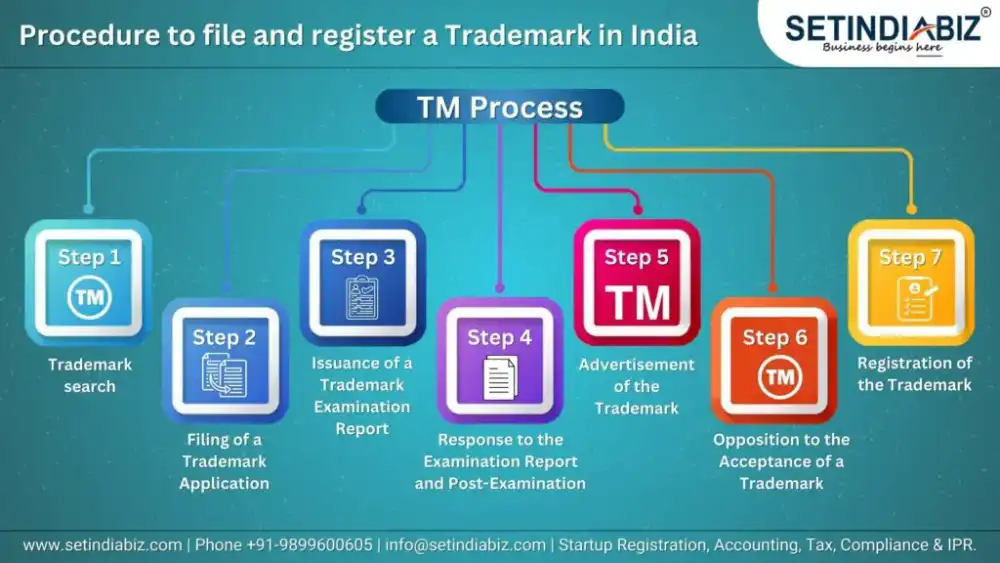A Guide For Registration of Trademark in India
Overview : A trademark plays a crucial role in a business. The reason behind registering a unique & special mark of a business is to form exclusivity for the usage & ownership of the mark and to provide legal protection against any sort of misuse. Develop insights into Trademark i.e. its Types, Documents Required, and Process to Register a Trademark, etc.
A trademark is a visual representation of words, a name, a device, a logo or label, or the numeric values of a company. The company uses its trademark to distinguish its goods and services from similar goods and services provided by another company. A trademark distinguishes the goods and services offered, sold, or rendered by a person/company from similar goods and services.
A trademark is an untouchable asset or intellectual property for a business once registered. It protects the company’s investment in the brand, logo, or ideogram/ representation. A trademark is registered when it is distinctive for the goods and services offered.
Trademarks that are identical or similar to an already existing or registered trademark are difficult to attain distinctiveness or recognition. Furthermore, trademarks that are misleading, generic, offensive, similar, contain exclusively protected emblems, and so on, cannot be registered.
The Controller General of Patents, Designs, and Trademarks (CGPDTM), under the Ministry of Commerce and Industry, provides registration of trademarks In India. A registered trademark grants the trademark owner the right to sue for damages if their trademark is violated. Once a trademark is registered, it will be valid for a period of ten years. However, registered trademarks that are about to expire can easily be renewed by filing a trademark renewal application for an additional ten years.
01 - Check Registration Criteria
Note: Conduct a search on IP India official website for the existing mark that are identical or similar to yours
02 - Apply for a Trademark
Note: – Prepare a clear graphical representation of your trademark and list of goods and services for which the application is being filed.
03 - Examination
Note: The trademark registry will examine your application to ensure that it fulfills the registration requirement
04 - Publication
Note: Once accepted by the examiner your application will be published for four months, where any party may oppose the application.
05 - Registration
Note: You will receive an e-certificate of registration from the Registry of Trademark in India and protection is granted for a period of 10 years from the date of filing of application.
Benefits of a Trademark Registration
The ability to protect one’s brand is the most significant advantage of having a registered trademark. Furthermore, a strong brand can be a direct link between the customers and the product/services by ensuring that they are trustworthy and have a well-known and extensive standing with the company.
There are numerous other advantages for example;
- Trademark registration lends credibility to the source of the goods or services.
- A registered trademark ensures that goods and services are of high quality.
- A registered trademark helps to promote both goods and services.
What are the different types of Trademarks?
In general, there are different types of trademarks that can be registered. Apart from visual trademarks like logo, brand name, slogan, etc. the music or voice related to any product/service can also be registered. Some types of trademarks are described below;
- Fanciful and Arbitrary marks: The most powerful trademarks are those that are fanciful and arbitrary. The mark does not describe the product or service to which it is attached in any way. An arbitrary mark is a common word that represents arbitrary goods or services, as opposed to a fanciful mark, which is a completely made-up word. The best choice for a trademark is a fanciful or arbitrary mark. An example of an arbitrary trademark is “Camel” in connection with cigarettes.
- Suggestive marks: It describes the product or service they represent in an indirect manner. The mark does not directly refer to or describe the product or service; rather, it hints at some of the product or service’s characteristics. An excellent example of a suggestive trademark is Walmart since it is suggestive for retail stores because the name implies a “mart”.
- Descriptive marks refer to and describe the product or service they represent directly. Descriptive words cannot be registered as trademarks under current law. However, if the mark has acquired distinctiveness or secondary meaning, it may be eligible for trademark registration. “Sugar-Free” is a descriptive trademark for a sugar substitute.
- Generic mark: is a commonly used word, mainly in the English language, to identify products or services. For example, the word “pencil” is a generic mark for a brand of pencils. A generic word can only be registered easily as a trademark. On the other hand, some brands have become household names due to years of consistent use. For example, the photocopying term “Xerox” has become a generic term.
For maximum protection, choose a fanciful or arbitrary word as a trademark. A descriptive mark offers limited protection, whereas a generic mark cannot be registered as a trademark.
Also check: International Trademark Registration
Procedure to file and register a Trademark in India

Step 1: Trademark search
Because there are so many different types of trademarks in the market, it is critical to conduct a trademark public search on the Trade Marks Registry’s database once a trademark is chosen to ensure that it is distinctive or unique and that no other mark is similar or identical to the chosen trademark.
The trademark search reveals all types of trademarks currently in the market, whether registered or unregistered. The search also determines whether the applied trademark competes with another.
Step 2: Filing of a Trademark Application
Depending on the company’s goods and services, the trademark application can be filed in a single-class or multi-class format. Form TM-A is the trademark registration application form, and depending on the jurisdiction of the trademark, it can be filed online through the official IP India website or in person at the Trade Marks Office.
A trademark registration form needs the following information:
- Information about the Applicant
- The mark was chosen for registration.
- A list of the goods or services that the mark will cover
- The statement of use (date of first use), i.e., the date since you’ve been using the mark, or, if you haven’t already, it would be filed on a “proposed to be used” basis.
Step 3: Issuance of a Trademark Examination Report
After the trademark application has been filed, a trademark examiner will review the application for any discrepancies. The examination report could take two to four months from the date the application is filed. After reviewing the application, the trademark examiner normally raises either of the two objections:
Absolute grounds — When the mark lacks distinctiveness or cannot distinguish one company’s goods or services from another. This is most likely to occur if you have chosen a descriptive or generic word as your trademark. For example, suppose you choose the word “tech” as a trademark for your technology-related services.
In that case, it will be rejected on the absolute grounds that the trademark is descriptive. As a result, as previously stated, choosing an arbitrary or fanciful mark as your trademark is preferable.
Relative grounds— apply when the mark is similar or identical to a previously registered trademark on the Trademarks Register. If your mark is similar or identical to a previously registered mark, the examiner will object on the same basis.
Suppose there are no objections by the trademark registry after examination of the applied mark. In that case, your mark will be advertised in the Trademarks Journal.
Step 4: Response to the Examination Report and Post-Examination
From the date of receiving the objections, you will have one month to respond to them. Your application is deemed abandoned if you do not respond within one month.
Once the Applicant has responded and the trademark examiner has accepted the trademark, it will be published in the Trademark Journal. Otherwise, you will be summoned to a show cause hearing if the Trademark Examiner has any further objections. A “show cause” hearing entails appearing before the Registrar of Trademarks or Hearing Officer with the necessary documents and evidence to persuade him to proceed with the registration of the mark. The hearing notice is typically sent 30 to 15 days before the hearing date.
If the Trademark Examiner/Hearing Officer is convinced, he may submit the mark for publication in the Trade Marks Journal. The mark may be abandoned if the Trademark Examiner/Hearing Officer is not persuaded.
Step 5: Advertisement of the Trademark
Once the trademark application is approved, the trademark is advertised and published for four months in the Trademark Journal. The publication and advertisement are intended to encourage the general public to file an opposition to the mark’s registration.Step 6: Opposition to the Acceptance of a Trademark
After the mark is advertised in the Trademarks Journal, any third party may file an opposition within four months of the publication date in the Trademarks Journal. The trademark opposition must be submitted to the Registry using the Form TM-O.
The notice is served on you if the Trademark Registry is satisfied that all requirements have been met. You must file a counter-statement on Form TM-O within two months of receiving the notice of opposition.
The application is deemed abandoned if you do not file a counter-statement within two months. After that, the opponent and you will file the evidence.
First, within two months of receiving the counter-statement, the opponent must file the evidence as an affidavit under Rule 45 (Evidence in Support of Opposition). The opposition may also elect to forego filing the affidavit and instead rely on the facts stated in the notice of opposition.
You must submit your evidence by way of affidavit under Rule 46 (Evidence in support of application) within two months of receiving the evidence or rely upon a letter from the opponent. You also have the option of not producing any evidence and instead relying on the facts stated in your counter-statement. The opponent can produce additional evidence within one month of receiving your evidence or rely upon the letter.
After that, the submission stage of evidence comes, wherein the Registry schedules a hearing and notifies both parties. The Registrar will decide whether or not to register the trademark after hearing from both parties.
The mark will be registered if no objection is raised within this time frame.
Step 7: Registration of the Trademark
The final step is registration of the said mark. The application proceeds to registration after overcoming objections and opposing the said trademark registration. Furthermore, there are no objections to trademark registration during the four-month advertisement and publication period.
In that case, the trademark is issued an auto-generated registration certificate within one week. Once the trademark is registered, it will be valid for a period of 10 years. To enjoy proprietary rights, a registered trademark must be renewed within a prescribed period. The renewal can be filed through Form TM-R.
Documents required for trademark registration
Trademark registration is a necessary procedure that protects a brand/business from unauthorized use and infringement.
The Indian government has simplified the trademark registration procedure over time, allowing entrepreneurs to obtain trademark registration for their applied marks in a few months rather than years earlier. A trademark applicant is required to file documents during three stages:
- Trademark application filing
- Show cause hearing on objection raised by the registry
- Opposition reply- the documents are required to be filed at evidence stage.
It is also important to note that submitting original documents during the trademark application registration procedure is optional. Scanned copies of the below-mentioned original documents would meet the requirement.
Documents required for trademark application filing
Any person (Applicant), whether an Indian or foreign national, can easily register a trademark in India. Also, it is pertinent to note that the documents required to register a trademark in the name of a corporation are the same as those required for an individual, which is as follows:
- A copy of the proposed logo, preferably in black and white (optional) or CMYK codes in the case of a coloured logo. However, if no logo is provided, a trademark application for the word can be filed;
- Form 48, or Power of Attorney, which has been duly signed and stamped. This Form authorizes a trademark attorney to file the trademark registration application on the Applicant’s behalf;
- User proof of the trademark application and user affidavit by the Applicant in case the applicant is using the trademark
- Startup recognition certificate or MSME certificate, if any. MSME certificate is also known as Udyam registration.
- The application fee for trademarks in India ranges from Rs. 4500 to Rs. 9000.
We at Setindiabiz help you promptly and correctly file trademark applications with the Registry of Trademarks.
Conclusion
Trademark registration is the best tool to protect your business IPR i.e. logo, slogan, mark, name and/or other visual representation. Your trademarked mark makes your products/services easily recognizable by your existing as well as potential customers and distinguishes it from the similar products/services by a different brand. Protect your business’s inseparable identity by following the procedure for registration of trademark.
FAQ's
The procedure for registration of trademark in India typically takes 6 months to 1 year to complete from the date of filing the application. However, the duration can increase based on the completion of your application, the number of objections and oppositions received, and the workload of the Trademark Registry Office. The time duration may extend to a few years as well.
In India, a trademark once registered, receives a valid protection for ten years from the date of filing the application. You can renew the registration by filing the renewal application 6 months before the date of expiry. There is no limit on the number of times a trademark can be renewed, however the validity of the renewed registration lasts for 10 years at a time.
Yes, you can use a trademark without registering it. However, registering your trademark provides stronger legal protection and exclusive rights of ownership to you, making it easier to enforce your rights against infringement.
Author Bio

Editorial Team | in
Setindiabiz Editorial Team is a multidisciplinary collective of Chartered Accountants, Company Secretaries, and Advocates offering authoritative insights on India’s regulatory and business landscape. With decades of experience in compliance, taxation, and advisory, they empower entrepreneurs and enterprises to make informed decisions.
